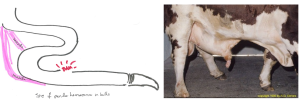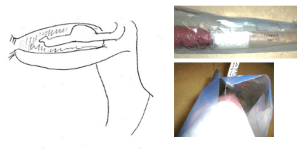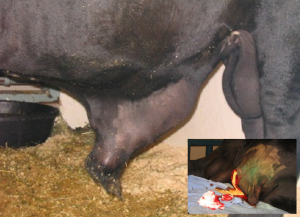Food Animal Male Urogenital Surgery
Penile hematoma
The most common penile injury in breeding bulls is penile hematoma (broken penis). Rather than just a small vessel rupture, these are generally tunica albuginea ruptures. A bovine penile hematoma usually refers to the rupture of the tunica albuginea of the penis. It can also be called a “broken penis”or a “fractured penis.” This is a serious injury and usually causes infertility.
The amount of pressure in the bull’s erect penis is very high. If the bull bumps the cows flank, something has to give. The penis almost always ruptures at the base of the sigmoid flexure at the level of the retractor penis muscle attachments. It ruptures on the dorsal surface. This area is weaker due to the bending required. This results in a bleed on the dorsum of the penis with the size of the hematoma related to the amount of breeding attempted by the bull after the injury.
Diagnosis
Diagnosis is made by identifying swelling within the sheath at the bend in the sigmoid flexutre. The penis can’t extend due to swelling; forced manual extraction or electroejaculation should not be used as these will cause more bleeding. Secondary signs include preputial prolapse secondary to the swelling within the sheath. The prepuce is usually swollen with bluish cast. Brusing of the skin may be seen in light skinned animals. A symmetric swelling should be palpable on the dorsum of the penis at the neck of the scrotum.

Location and symmetrical swelling are key. Abscesses are a common complication but are typically more distal and seldom symmetric. Ultrasound can be useful. Do NOT aspirate. This requires passing the needle through the contaminated sheath.

Treatment
Conservative treatment includes forced sexual rest for 60 days. Antibiotics are recommended in order to prevent abscessation of the hematoma. and treatment. Procaine penicillin (22,000 IU/kg im) is given twice daily for 7-10 days. Hydrotherapy can be used to stimulate circulation and reduce edema. The prolapsed prepuce is kept moist and protected using ointments and wraps. These are replaced twice daily.
A complete breeding soundness examination should be performed prior to breeding. Most (80%) bulls with hematomas <20cm in diameter recover with conservatives treatment; the number drops to only 33% success rates if the hematoma is >20cm in diameter.
Surgery can be performed to suture the tunic closed and remove the hematoma and is recommended for hematomas >20 cm in diameter; this increases the success rate to 75%. Surgery should be done between day 3 and 7 after injury in order to let the bleeding resolve but allow surgical access before adhesions developed. These cases should be referred for surgery if that is an option; most veterinarians do not see enough of these to develop proficiency.
Complications
Complications are common
- loss of nerve sensation due to damage to dorsal nerve
Sensation is required for intromission and ejaculation. Damage to the nerve may be immediate or delayed. Delayed damage occures due to incorporation of nerves into the scar tissue and subsequently stretched or torn during breeding. These bulls may still be collected via ejaculation
- adhesions within sheath
Adhesions may prevent complete extension of penis. Adhesions are more likely if abscessation develops. A wrinkle in the sheath will be evendent with attempeted penile extension (see wrinkle in sheath. )
- abscess of hematoma
The hematoma is an excellent culture media. This complication caries a poor prognosis.

- recurrence of hematoma
Recurrence is potentially related to an aggressive or clumsy bull?
- development of vascular shunts
Vascular shunts occur due to poor healing of the break and prevent erection. Diagnosis involves contrast radiographs. 15ml Conray is injected into the corpus cavernosum for each exposure
- damage to exposed prepuce
Exposure can lead to preputial damage
Resources
Medical and Surgical Management of Conditions of the Penis and Prepuce, 2024 VCNA
Penile and preputial problems in the bull, MS Gill
Penile amputation after trauma, case report
Just by looking at the location, you should be able to tell this isn’t a hematoma. What is the clue?
Answer – asymmetry. It is off to the side

